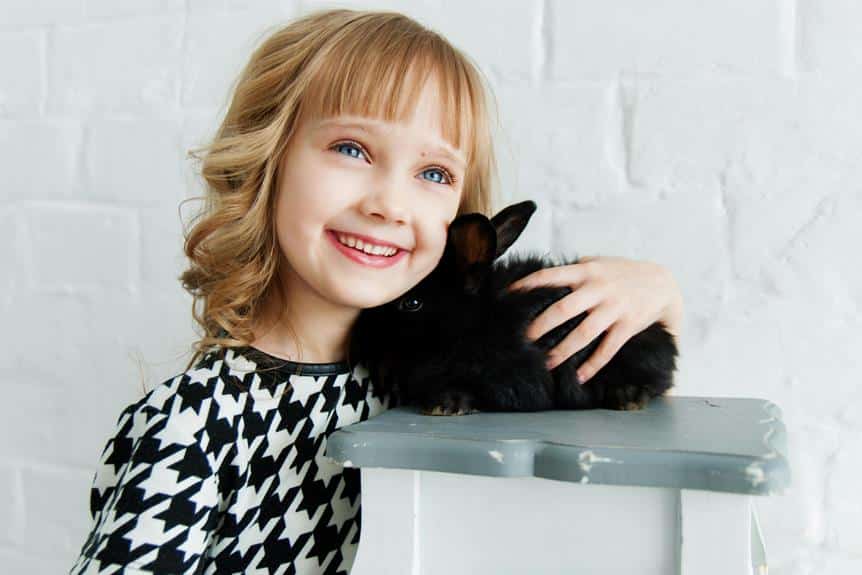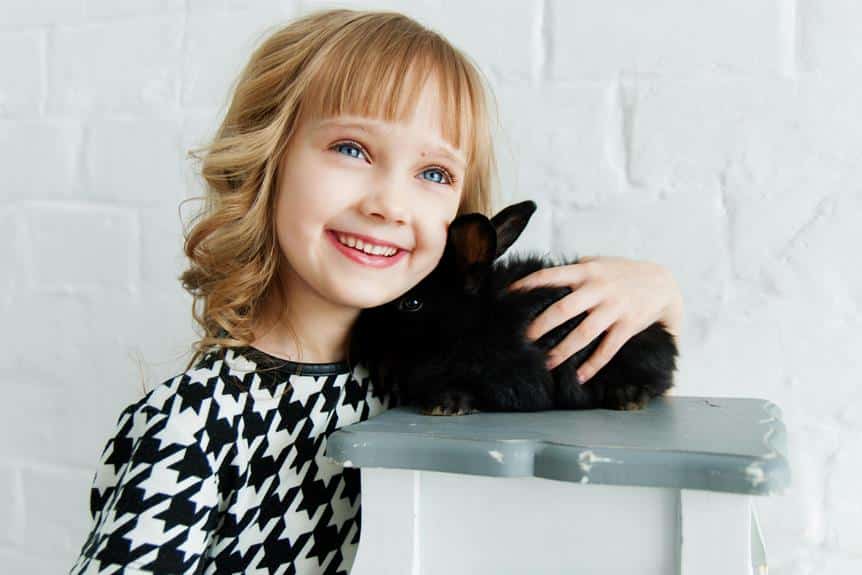Table of Contents
Have you ever wondered what your fluffy companion is really thinking? While they may not be able to communicate with words, rabbits have their own unique way of expressing themselves through body language. Paying attention to their subtle cues can provide valuable insights into their emotions and needs.
From the position of their ears to the movement of their tail, every twitch and twitch can reveal a hidden message. So, if you’re curious to unravel the mystery behind your bunny’s behavior, get ready to embark on a fascinating journey of decoding rabbit body language.
Key Takeaways
- Pay attention to your rabbit’s ear position, as it can indicate their emotional state. Relaxed and slightly forward or to the side ears indicate calmness and contentment, while flattened against the head ears suggest fear or aggression.
- The position and movement of the tail can also provide insights into your rabbit’s emotions. A raised tail signifies alertness and excitement, while a tucked tail indicates fear or submission. Tail thumping on the ground suggests your rabbit is feeling threatened or warning others.
- Eye contact and blinking can convey important messages. Direct eye contact is a sign of trust and affection, while avoiding eye contact may indicate fear or submission. Rapid blinking indicates relaxation, while wide eyes and a tense expression may suggest feeling threatened or anxious.
- Observe your rabbit’s overall body posture and movements. Stretching out hind legs and relaxing onto the belly indicates contentment and relaxation, while crouching low to the ground suggests feeling vulnerable or scared. Binkying, which is jumping and twisting in the air, shows that your rabbit is feeling happy and playful.
Ears: The Key to Understanding Your Bunny
To understand your bunny’s emotions and intentions, pay close attention to their ears, as they serve as a key indicator of their current state. Understanding ear movements is crucial for decoding your bunny’s emotions and effectively communicating with them.
When your bunny’s ears are in a relaxed position, with their tips pointed slightly forward or to the side, it indicates that they’re calm and content. This is the ideal ear position for a relaxed bunny who feels safe and secure in their environment.
However, if your bunny’s ears are pointed straight up and their eyes widen, it signifies alertness and curiosity. They’re likely focusing on something that has caught their attention. This position is often seen when they’re exploring new surroundings or when they hear unfamiliar sounds.
On the other hand, if your bunny’s ears are flattened against their head, it suggests fear or aggression. They may feel threatened or stressed, and it’s important to assess the situation and provide a safe and calm environment for them.
Tail: What Your Bunny’s Behind Is Saying
Your bunny’s tail is a crucial part of their body language, providing valuable insights into their emotions and communication. Paying attention to your bunny’s tail can help you understand their current state of mind and respond accordingly.
Here are four key things to look out for when observing your bunny’s tail:
- Position: A relaxed and neutral tail position indicates that your bunny is calm and content. It will be held low, parallel to the ground, with a slight curve at the end. On the other hand, a raised tail suggests alertness and excitement, while a tucked tail indicates fear or submission.
- Wiggling: A wiggling tail can signify happiness and excitement. If your bunny greets you with a wagging tail, it means they’re pleased to see you and are in a positive mood. However, be cautious if the wiggling is accompanied by other signs of aggression or distress.
- Thumping: Rabbits have a unique behavior called ‘thumping,’ where they forcefully stomp their hind legs on the ground. This is a clear indication of danger or perceived threat. It’s their way of warning others and communicating potential danger.
- Fluffiness: When a bunny’s tail becomes puffy and erect, it’s a sign of extreme fear or aggression. This is often accompanied by other body language cues like lunging or growling. It’s crucial to give your bunny space and avoid any sudden movements to prevent further stress or aggression.
Understanding your bunny’s tail language is an essential skill for any rabbit owner. By paying attention to their tail movements, you can better understand their emotions and respond appropriately to their needs.
Eyes: Window to Your Bunny’s Soul
As you continue to decode your bunny’s body language, the next area of focus lies in their eyes, providing a deeper glimpse into their thoughts and emotions. Eye contact is an essential aspect of rabbit communication. When your bunny makes direct eye contact with you, it’s a sign of trust and affection. They’re trying to establish a connection and convey their emotions to you. On the other hand, avoiding eye contact may indicate fear or submission.
Blinking patterns can also reveal important information about your bunny’s state of mind. Rapid blinking, similar to a human’s eye flutter, often indicates relaxation and contentment. It’s a signal that your bunny feels safe in its environment. On the contrary, slow blinking can be a sign of sleepiness or a relaxed state. It’s important to observe your bunny’s blinking patterns in different situations to understand their specific meanings.
When interpreting your bunny’s eye language, it’s crucial to consider the context and other body language cues. For example, if your bunny is displaying other signs of fear, such as flattened ears or a lowered stance, it may be best to give them space and allow them to feel safe. Understanding your bunny’s eye contact and blinking patterns will help you build a stronger bond and better meet their needs.
Body Posture: Decoding Your Bunny’s Stance
Understanding your bunny’s body posture is essential for interpreting their communication and gaining insight into their emotions and intentions. Here are four key aspects to consider when decoding your bunny’s stance:
- Leg position: Deciphering the meaning behind your bunny’s leg stance can provide valuable information about their mood and level of comfort. For example, when your bunny stretches out their hind legs and relaxes onto their belly, it indicates a feeling of contentment and relaxation. On the other hand, if they tuck their hind legs tightly under their body and hunch their back, it may suggest fear or a defensive posture.
- Facial expressions: Understanding the emotions conveyed through your bunny’s face is crucial in interpreting their body language. A relaxed and content bunny will have a soft, open expression with their eyes half-closed and their ears upright. Conversely, a bunny with wide eyes, flattened ears, and a tense expression may be feeling threatened or anxious.
- Body position: The position of your bunny’s body can provide insight into their level of comfort and trust. When your bunny sits or lies down with their body stretched out, it indicates that they feel safe and secure in their environment. However, if they crouch low to the ground or huddle in a corner, it suggests that they’re feeling vulnerable or scared.
- Tail position: Pay attention to your bunny’s tail position as it can convey important information about their emotions. A relaxed bunny will have their tail in a neutral position, neither lifted high nor tucked tightly against their body. Conversely, a bunny with their tail raised high indicates excitement or curiosity, while a tucked tail suggests fear or submission.
Vocalizations: Listening to Your Bunny’s Language
Deciphering your bunny’s body language is just one aspect of understanding their communication; another important facet is listening to their vocalizations.
Rabbits use vocal cues to express their emotions, needs, and desires. By understanding the different types of bunny vocalizations, you can better respond to your bunny’s needs and strengthen your bond with them.
Rabbits have a range of vocalizations that can vary in pitch, tone, and intensity. The most common vocalization is the gentle purring sound, which indicates contentment and relaxation. On the other hand, loud and high-pitched squealing or screaming may indicate pain, fear, or extreme agitation. Growling or grunting sounds are often a sign of aggression or territorial behavior.
When your bunny vocalizes, it’s crucial to pay attention and respond accordingly. If your bunny purrs, it means they’re feeling calm and content. You can respond by giving them gentle strokes or providing a quiet and safe environment. However, if your bunny is screaming or growling, it’s essential to assess the situation and remove any potential threats or stressors. Offer reassurance and a calm presence to help them feel safe.
Understanding your bunny’s vocal cues is vital for their well-being and your relationship with them. By listening and responding appropriately, you can create a nurturing and supportive environment for your furry friend.



